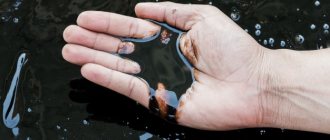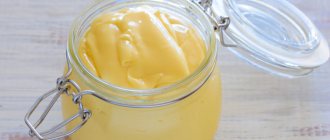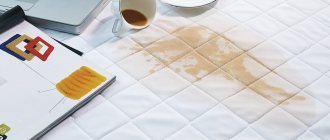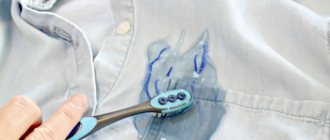The creative process often ends in trouble, for example, after modeling with plasticine, a child may have stains on his T-shirt, shorts, or dress. The composition of the plastic mass includes complex components: dyes, wax, fats. Such substances do not dissolve in water and cannot be washed with ordinary powder. However, they can be removed if you follow a certain algorithm and use products that break down plasticine.
The stuck lump can be cleaned off with the plastic stack that comes in the modeling kit, and then put the clothes in the freezer. The plates can be finally removed after it has hardened. The mass will crumble and fall away from the fabric. After this, the stain can be washed off using laundry soap.
Heat treatment methods
First you need to remove the bulk of the substance with the blunt side of a knife or a spatula. Afterwards, to remove traces of plasticine from clothes, it is recommended to heat or freeze the plasticine. When frozen, paraffin and other substances in plasticine harden, as a result of which its sticky properties are reduced, so the material is more easily separated from the fibers of clothing. To clean plasticine marks on textiles, you can use the following methods:
- pack the item in a plastic bag and place in the freezer for 1-1.5 hours;
- place a metal bowl with ice on the stain and wait 10 minutes;
- Apply a bag of ice cubes to the contaminated area and hold until it begins to melt;
- Spray the dirty area with an aerosol for cooling microcircuits or an anesthetic spray used for injuries.
After freezing, the hardened material is carefully kneaded, breaking into small pieces, and the remains are removed with a spatula or a hard-bristled brush. At the same time, you should not rub the stain vigorously, otherwise it will soften and eat deeper into the fabric. You can also remove plasticine marks from clothes using an iron. This method is suitable for thick fabrics. The action algorithm will be like this:
- place a paper napkin under the stain, another one on top of it;
- turn on the low temperature mode on the iron;
- Carefully iron the napkin several times (during warming up, plasticine should remain on it);
- change the paper when it gets dirty.
If your black trousers are dirty
Black fabric of school or children's dress pants, despite its dark color, is very easily soiled. Any abrasions and marks are visible on it, including those from plasticine.
But even in such a situation, proven methods will come to the rescue. First, turn your pants inside out. Next, proceed according to the scheme below.
- Lay your pants out on an ironing board or any other flat, horizontal surface.
- Place paper napkins on the stain above and below (under the fabric).
- Preheat the iron.
- Run the sole of the device over the napkins. You will immediately see that grease stains from the trousers transfer to the paper.
- Change napkins and repeat the procedure until the stain completely disappears.
- Treat the stained area with soapy water, then wash the item completely.
To ensure that the color of your pants remains charcoal black for a long time, add special products to the powder during washing that are responsible for preserving the shades. Fortunately, there is now a wide selection of them in stores.
Plasticine stains are not the most unpleasant thing for you and your clothes. If you act quickly and carefully, you will be able to return things to their store-bought appearance.
Soda and soap
Laundry soap does most of the work, and soda perfectly complements it, increasing efficiency. The proposed method helps to clean plasticine from any type of fabric. You need to do the following:
- fill a suitable container with warm water, dissolving in it 100 g of laundry soap, previously grated;
- soak the dirty item in the solution for an hour;
- lightly clean the area of contamination with a brush, while simultaneously removing plasticine lumps from the pile;
- combine baking soda (2 tbsp) with water (1 tbsp) to make a thick paste;
- Rub the resulting mixture into the stain for 2-3 minutes, rinse with water.
Vegetable oil
This method is suitable for any fabric and is considered one of the most effective in the fight against sticky stains. To remove plasticine from clothes, you must:
- soak a cotton swab with oil;
- wipe the dirty area with it (do this for 2 minutes);
- after the oil reacts with the fats in the plasticine, the stain will dissolve;
- the remaining greasy trace should be treated with dishwashing detergent and left for an hour;
- Next, rinse the clothes with water.
Getting rid of greasy marks
In principle, you can do without a machine. Take wet wipes and wipe the area where the plasticine was. Before doing this, the item needs to be dried again so that you can see what you are doing.
You have already completely washed the colored component from the plasticine in the first stage. The greasy mark has no color, so you will not see it on wet fabric. At first glance, it may seem to you that it is already clean, but this is not so.
Let the item dry and perform manipulations with wet wipes. In most cases, this helps to completely get rid of traces of plasticine. The item can be put on and worn.
If you don't have wet wipes in your house or you can't remove greasy marks with them, take a hand sanitizer. Spray a little on the stain, a little on a soft cloth. Rub the stained area with a rag. Press harder so that the disinfectant liquid penetrates deep into the fibers. It dries very quickly, so you will see the results of your work almost immediately.
Ammonia
This product can easily cope with sticky stains on natural fabrics. When using ammonia, be sure to ventilate the room. Clothes should be dried in the fresh air after the procedure. A great way to help clean plasticine from things:
- mix 10 drops of the product with 200 ml of water;
- soak a cotton pad in the solution and wipe the dirt with it until completely clean;
- rinse the item under running water;
- wash with powder in a machine or by hand.
In case of extensive contamination, it is better to prepare several liters of solution (in proportions of 1:20) and soak the item for half an hour. Then the stain should be lightly rubbed, rinsed and washed.
- How to lose weight in the abdominal area
- Accelerating metabolism for weight loss - food and drugs to improve metabolism
- What can be made from clay
Common mistakes
To avoid damage to the contaminated item, the following operations should be avoided:
- Remove the layer of plasticine with the sharp side of the knife blade;
- Scrape and clean the stain, starting from the center, increasing the size of the damaged area. Correct direction: from edge to middle;
- Wipe plasticine from fabric without pre-treatment with iron or cold. First you will need to remove most of the sticky mass, then remove the remaining pieces and traces;
- Immediately pour solvent or kerosene onto the surface without first testing it in an inconspicuous area. This will lead to the formation of stubborn stains;
- Use alcohol and solvents on varnished, vinyl, and synthetic surfaces;
- Wipe off lumps with a dry or damp cloth - the area of contamination will increase;
- Wash the stain without prior preparation;
- Clean the material with your fingers, rinse with water, wipe with napkins. As a result of such actions, the mass will penetrate deeply into the fibers;
- Work with aggressive chemical compounds with closed windows without gloves.
Before removing a plasticine stain with the chosen product, you should test its effect on an inconspicuous area of clothing. If the color or structure of the fabric changes, you should choose another method.
Kerosene
Today, the substance is sold in purified form, so you don’t have to worry about the need to remove strong odors from clothes. Kerosene should be used with extreme caution as it can corrode the paint and structure of delicate fabrics. An effective way to clean plasticine stains:
- place the soiled product on a table or any other hard surface;
- wet a cotton swab with kerosene, wring it out, apply to the stain for 8-10 minutes (5 minutes is enough for delicate fabric);
- clean the remaining substance with dry wipes by repeated application;
- Wipe the cleaned area with a slice of lemon and wash the clothes as usual.
Difficulties in cleaning different fabrics
The method for removing plasticine from clothing is determined by the type of fabric:
White material - oxygen bleach, hydrogen peroxide, baking soda, laundry soap and ammonia help to quickly clean light-colored wardrobe items. Oxygen bleach removes stains well. The use of preparations containing chlorine (for example, bleach) is not recommended;
Colored material - when processing bright prints, it is important to maintain image clarity. Acetone solvents and chlorine-containing compounds have a negative effect on the color. Laundry soap, vegetable oil, and a mixture of dishwashing detergent and soda will give a positive result;
Black things - ordinary vegetable oil will help remove plasticine from dark trousers, jacket and skirt, followed by applying dish gel or soda;
Silk - pure alcohol will help remove traces of plasticine on delicate fabrics. Place the stained item on a flat surface with the stain facing up. Place a paper towel under the stain. Blot stains with a cotton swab soaked in alcohol until completely clean;
Jeans - before removing plasticine from cotton clothes, stock up on solvents: white spirit, purified kerosene, an aqueous solution of ammonia (10 drops per 250 ml of water), acetone. The color of the jeans deserves special attention. A suitable means for cleaning light-colored, monochromatic items is laundry soap. Alkaline compounds (potassium or sodium salt) and natural fatty acids contained in its composition perfectly break down contaminants;
Wool - products with an uneven surface and porous structure are at risk of deep penetration of cleaning agents. Gentle stain removal is carried out with turpentine, kerosene, purified gasoline, and nail polish remover without acetone.
White woolen items turn yellow when exposed to solvents; housewives recommend taking them to the dry cleaner.
Isopropyl alcohol
This method of cleaning plasticine is only suitable for cotton items. You cannot use alcohol on other materials, as this will ruin them. To clean a sticky stain:
- place damaged clothing on a hard surface;
- moisten the area of contamination with a few drops of alcohol;
- after a minute, wash off the remaining alcohol from the item;
- wash the product immediately after this.
Isopropyl alcohol is a flammable substance; any interaction with it must be carried out in compliance with safety rules. It is necessary to work with liquid and store it away from open flames and sources of high temperatures. Alcohol quickly evaporates when mixed with air, and at high concentrations forms an explosive composition, so work with the substance should be carried out in well-ventilated areas. In addition, wear gloves - with prolonged contact with skin, alcohol can cause chemical burns.
How to wash clothes that have plasticine on them
The last step will be a classic wash. It is required in all cases, because simply wiping off the stain is not enough. It is imperative to start washing immediately in order to have time to get rid of the tiny pieces of plasticine that are located in the nearest layers of fabric.
The higher the temperature, the more likely it is to wash the item. However, you need to choose the mode that is acceptable for a particular type of material. Otherwise, there is a risk of completely ruining your favorite clothes.
Several additional cleaning methods - video:
Stain removers
Special chemicals for removing various stains are a great way to clean plasticine from clothes if the recipes described above did not help. To remove a greasy blot left by plasticine, stain removers are used as follows:
- moisten the area of contamination with warm water;
- dilute the stain remover in a small container, following the instructions on the package (the proportions are different for each product);
- pour the prepared mixture onto the dirty area and leave for 20 minutes;
- Place the clothes in the washing machine, add another portion of stain remover and start the wash.
How to remove stains using household chemicals
If it was not possible to remove stains left by plasticine using folk remedies, then you can resort to using household chemicals. In this case, many experienced specialists recommend purchasing industrial stain removers in specialized stores. As practice shows, they are excellent for all types of fabric, including white and colored items.
After you have purchased such a stain remover, you should carefully study the instructions, according to which you need to carry out further work to remove stains.
Advice! In order not to cause further damage to the product, do not deviate from the instructions.











